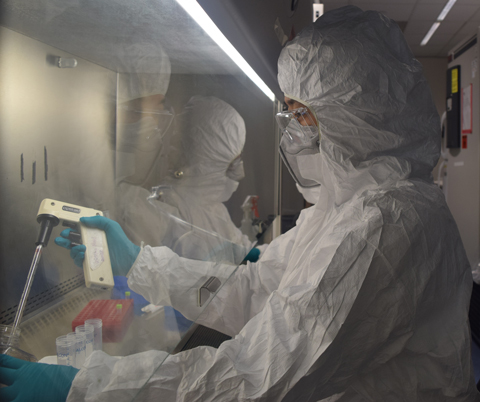October 27, 2020
Support from the U.S. Department of Defense Will Accelerate Progress on Vaccine Candidate for COVID-19, IAVI Says
NEW YORK — OCTOBER 27, 2020 — IAVI announced today the award of US$26.7M from the Defense Threat Reduction Agency (DTRA) of the U.S. Department of Defense (DoD) to support IAVI’s recombinant vesicular stomatitis virus (rVSV) vectored SARS-CoV-2 vaccine candidate. DTRA’s commitment will enable critical nonclinical development on the vaccine candidate that IAVI is developing in partnership with Merck (known as MSD outside the United States and Canada).
 Principal Scientist Maoli Yuan at IAVI’s Vaccine Design and Development Laboratory
Principal Scientist Maoli Yuan at IAVI’s Vaccine Design and Development Laboratory
DTRA’s award will facilitate the vaccine candidate’s clinical development path to licensure by supporting work at IAVI’s Vaccine Design and Development Laboratory (DDL) in Brooklyn, New York, to characterize immune responses in animals and demonstrate the safety and efficacy profile of rVSVΔG-SARS-CoV-2 vaccination in animals. These nonclinical data will be essential to supplement the clinical data package and to inform the most effective use of the vaccine in an ongoing pandemic. The award from DTRA comes from its Science and Technology New Initiatives, under the topic area Chemical/Biological.
“A safe, effective vaccine is critically needed for pandemic response,” stated Dr. John Trefry, science and technology manager for DTRA RD/CB. “The IAVI-Merck vaccine candidate has potential to make a valuable contribution to this global effort.”
“We are deeply grateful to the Department of Defense for this important commitment to advance COVID-19 vaccine research. It will enable us to conduct key nonclinical studies that will enhance our understanding of the immune responses elicited by our vaccine candidate,” said Mark Feinberg, M.D., Ph.D., IAVI president and CEO.
In May 2020 Merck and IAVI announced their collaboration to develop an investigational vaccine against SARS-CoV-2. This collaboration combines the vaccine research and development capabilities of Merck and IAVI and uses the same rVSV platform that underlies Merck’s Ebola Zaire virus vaccine, the first rVSV-based vaccine approved for use in humans. The COVID-19 vaccine candidate, V590, is currently in preclinical development, and clinical studies are planned to start this year. Merck will lead regulatory filings globally. Both organizations will work together to develop the vaccine as rapidly as possible, and make it accessible globally, if approved.
Swati Gupta, Dr.Ph., M.P.H, IAVI vice president and head of emerging infectious diseases and scientific strategy, said, “We are excited by the DoD’s partnership and enthusiasm for the rVSV technology and the potential advantages it offers. In particular, we are investigating a vaccination regimen of only a single dose, administered intramuscularly or orally. A single-dose vaccine, especially one given orally, could be advantageous in achieving rapid population coverage in the midst of a pandemic.”
Merck signed an agreement with the Biomedical Advanced Research and Development Authority (BARDA), part of the office of the Assistant Secretary for Preparedness and Response within an agency of the United States Department of Health and Human Services, that provides funding support for the program. The Government of Japan announced to the World Bank/International Monetary Fund Development Committee in April 2020, in partnership with the World Bank, its commitment to contribute $10 million to IAVI’s COVID-19 vaccine development program.
Since its founding in 2008, the IAVI DDL has become one of the world’s leading viral vector vaccine research and development labs, known for innovation and generation of novel vaccine design concepts. IAVI’s rVSV program at the DDL includes vaccine candidates for HIV and several emerging infectious diseases, including COVID-19. In November 2019 DTRA awarded IAVI $35.7M to advance research on an rVSV vectored Marburg virus vaccine candidate. That vaccine candidate is in preclinical development. Another IAVI rVSV vaccine candidate for prevention of Lassa fever is in preclinical development with support from the Coalition for Epidemic Preparedness and Innovation (CEPI); this candidate was recently found to have strong preclinical efficacy in animal studies, and clinical trials will begin in 2021.
IAVI’s rVSV HIV vaccine candidate has been made possible by many supporters, including the Bill & Melinda Gates Foundation; the Danish Ministry of Foreign Affairs; the Government of Canada; the Government of Japan, in partnership with the World Bank; the Irish Department of Foreign Affairs and Trade; the Louis & Rachel Rudin Foundation; the Netherlands Ministry of Foreign Affairs; the Norwegian Agency for Development Cooperation; the Starr Foundation; the U.K Department for International Development; the U.S. National Institutes of Health (NIH); and through the generous support of the American people from the United States Agency for International Development (USAID).
###
About the Defense Threat Reduction Agency
The Defense Threat Reduction Agency enables the Department of Defense, the United States Government, and international partners to counter and deter weapons of mass destruction (WMD) and improvised threat networks.
Countering WMD and improvised threats is a global problem that requires DTRA’s unique global presence and execution capabilities. As a Combat Support Agency, DTRA provides various forms of support to the Combatant Commands (CCMDs) and the military services with both defensive and offensive capabilities. The agency is uniquely prepared to address some of the most immediate, consequential, and non-conventional weapon threats to national security through leveraging and expanding collaboration with interagency and international partners.
As the DoD’s research and development leader focused on WMD and improvised threats, DTRA facilitates innovation through combining traditional research with unconventional means to develop and quickly field solutions to the most complex, deadly and urgent threats facing the United States and the rest of the world.
DTRA has over 2,000 uniformed military personnel and DoD civilians working on every continent except Antarctica. The agency has thousands of global engagements in more than 100 countries and in addition to multiple locations stateside and overseas, the agency has liaisons in many embassies.